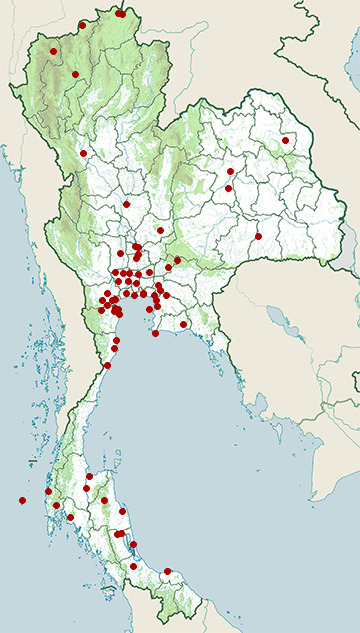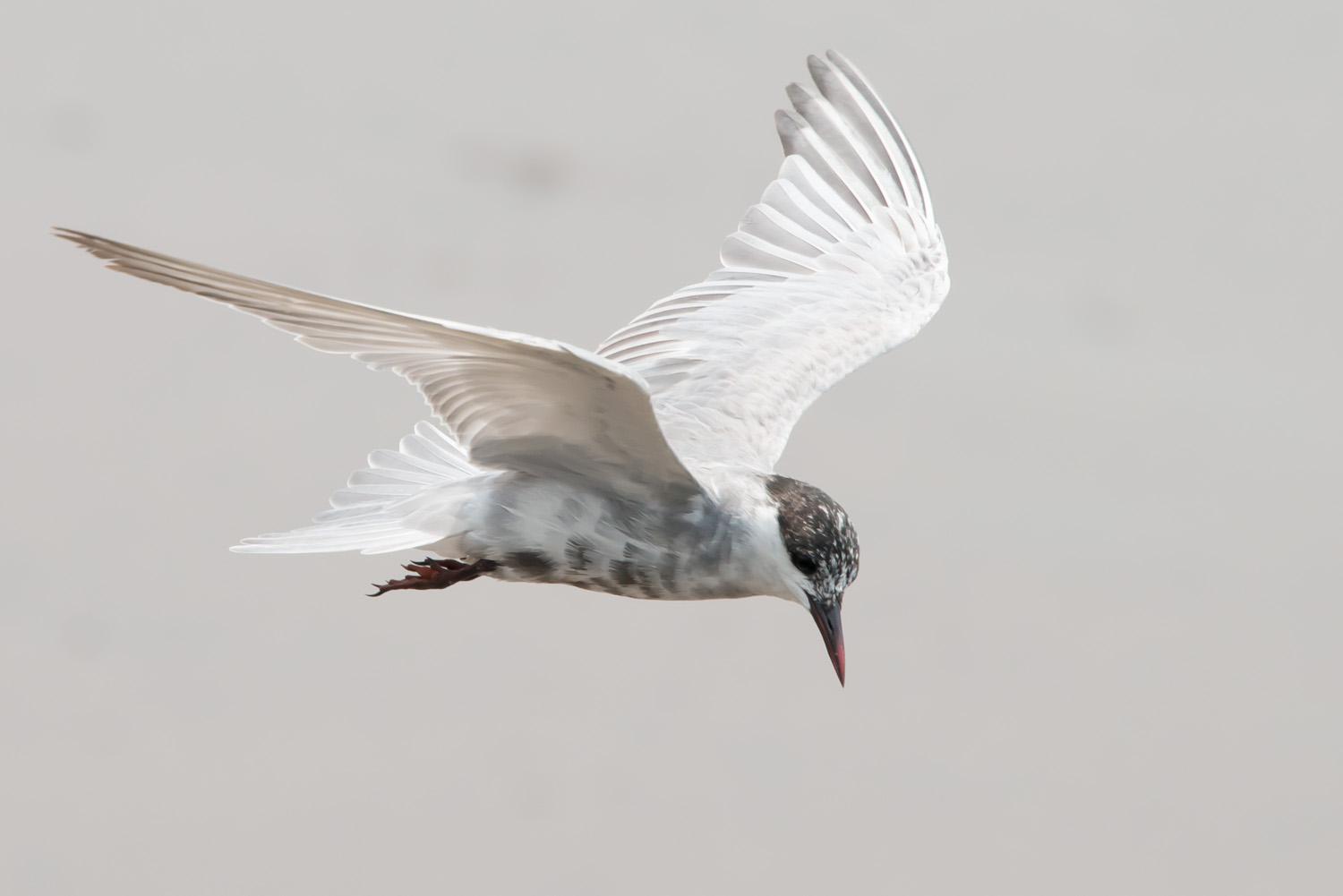Species of Thailand
Whiskered tern
Chlidonias hybrida
Peter Simon Pallas, 1811
In Thai: นกนางนวลแกลบเคราขาว
The whiskered tern (Chlidonias hybrida) is a tern in the family Laridae. The genus name is from Ancient Greek khelidonios, "swallow-like", from khelidon, "swallow". The specific hybridus is Latin for hybrid; Pallas thought it might be a hybrid of white-winged black tern and common tern, writing "Sterna fissipes et Hirundine natam”.
This bird has a number of geographical races, differing mainly in size and minor plumage details.
C. h. hybrida breeds in warmer parts of Europe and the Palearctic (northwestern Africa and central and southern Europe to southeastern Siberia, eastern China and south to Pakistan and northern India). The smaller-billed and darker C. h. delalandii is found in east and south Africa, and the paler C. h. javanicus from Java to Australia.
The tropical forms are resident, but European and Asian birds winter south to Africa and the Indian Subcontinent.
This species breeds in colonies on inland marshes, sometimes amongst black-headed gulls, which provide some protection. The scientific name arises from the fact that this, the largest marsh tern, show similarities in appearance to both the white Sterna terns and to black tern.
Description
The size, black cap, strong bill (29–34 mm in males, 25–27 mm and stubbier in females, with a pronounced gonys) and more positive flight recall common or Arctic tern, but the short, forked-looking tail and dark grey breeding plumage above and below are typically marsh tern characteristics. The summer adult has white cheeks and red legs and bill. The crown is flecked with white in the juvenile, and the hindcrown is more uniformly blackish, though in the winter adult this too is flecked with white. The black ear-coverts are joined to the black of the hindcrown, and the space above is mottled with white, causing the black to appear as a C-shaped band. The sides of the neck are white; this sometimes continues across the nape. The collar is less sharply defined. All through the year the rump is pale grey. In the juvenile, the mantle (279 mm) has a variegated pattern. The feathers of the back and scapulars are dark brown, with prominent broad buff edgings and often subterminal buff bars or centers. There is usually an admixture of new gray feathers, especially on the mantle, quite early in the fall. The mantle is silvery-gray in the adult.
The call is a characteristic krekk.
In winter, the forehead becomes white and the body plumage a much paler grey. Juvenile whiskered terns have a ginger scaly back, and otherwise look much like winter adults. The first winter plumage is intermediate between juvenile and adult winter, with patchy ginger on the back.
The whiskered tern eats small fish, amphibians, insects and crustaceans.
This article uses material from Wikipedia released under the Creative Commons Attribution-Share-Alike Licence 3.0. Eventual photos shown in this page may or may not be from Wikipedia, please see the license details for photos in photo by-lines.
Category / Seasonal Status
BCST Category: Recorded in an apparently wild state within the last 50 years
BCST Seasonal status: Non-breeding visitor
Scientific classification
- Kingdom
- Animalia
- Phylum
- Chordata
- Class
- Aves
- Order
- Charadriiformes
- Family
- Laridae
- Genus
- Chlidonias
- Species
- Chlidonias hybrida
Common names
- Thai: นกนางนวลแกลบเคราขาว
Conservation status

Least Concern (IUCN3.1)
Photos
Please help us review the bird photos if wrong ones are used. We can be reached via our contact us page.
Range Map

- Amphawa District, Samut Songkhram
- Ban Laem District, Phetchaburi
- Ban Phai District, Khon Kaen
- Ban Pho District, Chachoengsao
- Ban Phraek District, Phra Nakhon Si Ayutthaya
- Bang Ban District, Phra Nakhon Si Ayutthaya
- Bang Len District, Nakhon Pathom
- Bang Pahan District, Phra Nakhon Si Ayutthaya
- Bang Pakong District, Chachoengsao
- Bang Phra Non-Hunting Area
- Bang Pu Recreation Centre
- Bangkok Province
- Bangkok Coast
- Bueng Boraped Non-Hunting Area
- Chaiyo District, Ang Thong
- Chiang Saen District, Chiang Rai
- Doi Pha Hom Pok National Park
- Hat Yai District, Songkhla
- Kamphaeng Saen District, Nakhon Pathom
- Khao Luang National Park
- Khao Sam Roi Yot National Park
- Khao Yai National Park
- Khao Yoi District, Phetchaburi
- Khuan Khanun District, Phatthalung
- Klaeng District, Rayong
- Ko Sichang District, Chonburi
- Laem Pak Bia
- Mueang Chachoengsao District, Chachoengsao
- Mueang Chiang Mai District, Chiang Mai
- Mueang Chonburi District, Chonburi
- Mueang Khon Kaen District, Khon Kaen
- Mueang Krabi District, Krabi
- Mueang Nakhon Pathom District, Nakhon Pathom
- Mueang Pathum Thani District, Pathum Thani
- Mueang Pattani District, Pattani
- Mueang Phang Nga District, Phang Nga
- Mueang Phetchaburi District, Phetchaburi
- Mueang Prachuap Khiri Khan District, Prachuap Khiri Khan
- Mueang Ratchaburi District, Ratchaburi
- Mueang Samut Sakhon District, Samut Sakhon
- Mueang Samut Songkhram District, Samut Songkhram
- Mueang Suphanburi District, Suphan Buri
- Mueang Surat Thani District, Surat Thani
- Mueang Surin District, Surin
- Mueang Tak District, Tak
- Nong Bong Khai Non-Hunting Area
- Nong Han Lake
- Nong Thung Thong Non-Hunting Area
- Nong Ya Plong District, Phetchaburi
- Pa Sak Chonlasit Dam Non-Hunting Area
- Pai District, Mae Hong Son
- Pak Phanang District, Nakhon Si Thammarat
- Pak Phli District, Nakhon Nayok
- Pak Thale
- Pak Tho District, Ratchaburi
- Phanat Nikhom District, Chonburi
- Phutthamonthon District, Nakhon Pathom
- Pran Buri Forest Park
- Sai Noi District, Nonthaburi
- Samae San Island
- Samut Prakan Province
- Sathing Phra District, Songkhla
- Similan Islands
- Takua Pa District, Phang Nga
- Thale Noi Non-Hunting Area
- Thanyaburi District, Pathum Thani



